|
|
The whole town of Pafos is included in official UNESCO list of cultural and natural treasures of the world heritage. Wherever one treads in Pafos, comes across its glorious history, which dates back thousands of years, when cult of goddess Aphrodite, who emerged from its seas, flourished in this beautiful part of the world, attracting many visitors from inland and abroad.
Today, it is a growing harbor town, but in Hellenistic and Roman times it was the capital of Cyprus. Still under the spell of her Beauty-goddess, area retaining her magic has remained intact by time. It seduces its visitor with its majestic landscape, lovely coastline, historical treasures and delightful villages, where tradition is still a way of life.
Kept in harmony with nature are divine mediaeval monasteries, which lie peacefully in Pafos heartland.
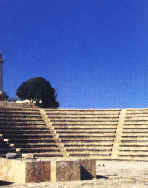
Pafos Ancient Odeon
Places of Interest:
Pafos District Archaeological Museum
Griva Digeni 43, Tel: (06) 240215
Attractive collection of Cypriot antiquities from Pafos area, dating from Neolithic Age to 1700 AD.
Byzantine Museum
A. Ioannou 3, next to the Bishopric. Tel: (06) 23 13 93
An attractive collection of objects from Byzantine period, including Byzantine icons from 7th to 18th centuries and the oldest icon found yet in Cyprus of 7th or 8th century.
Ethnographical Museum
Exo Vrysis 1, Tel: (06) 23 20 10
Interesting private collection of objects from Neolithic Age to the present day.
Pafos Mediaeval Fort
Kato Pafos harbor
Originally, a Byzantine fort built to protect the harbor, it was rebuilt by Lusignans in 13th century, dismantled by Venetians in 1570 and rebuilt by Ottomans after they captured the island in 16th century.
Agia Solomoni Church
Kato Pafos, Leoforos Agiou Pavlou
Originally, a Christian catacomb retaining some of 12th century frescoes. A sacred tree at the entrance is believed to cure ailments of those, who hang a personal offering on its branches.
Kato Pafos Archaeological Park
The inclusion of Kato Pafos archaeological area in the World Heritage List in 1980 sparked off the idea of the creation of a General Plan, whose main aim is to preserve and maintain archaeological remains and to promote and provide integral information to visitors.
Archaeological site of Kato Pafos includes areas and monuments from prehistoric times up to and including the middle Ages, with most remains dating to Roman period. Mosaic floors of four villas of Roman period are the epitome of all these findings. Other important monuments are Asklipeio, Odeon, the early Christian Basilica and Fort of Saranta Kolones
Tombs of the Kings
Kato Pafos, Tel: (06) 24 02 95
Spread over a vast area, these impressive underground tombs date back to 4th century BC. They are carved out of solid rock, with some being decorated with Doric pillars. High officials rather than Kings were buried here, but the magnificence of tombs gave the locality its name.
The Mosaics of Pafos
House of Dionysos, House of Theseus and House of Aion
Kato Pafos, close to the harbor, Tel: (06) 24 02 17
Mosaic floors of these noblemen's villas, dating from 3rd to 5th century AD, are considered among the finest in Eastern Mediterranean. They mainly depict scenes from Greek mythology.
Pafos Odeon
Kato Pafos
A small 2nd century Odeon built entirely of well-hewn limestone blocks. It is now used in the summer for musical and theatrical performances. Nearby are remains of ancient city walls, Roman Agora and a building dedicated to Asklipeios, god of medicine.
Saranta Kolones
Kato Pafos, close to harbor
Lusignans built this castle at the beginning of the early 13th century on the site of a previous Byzantine Castle. An earthquake destroyed it in 1222.
Panagia Limeniotissa Basilica
Kato Pafos, close to harbor
Built in the early 5th century and dedicated to 'Our Lady of Harbor', it was almost completely destroyed during 7th century Arab raids.
Panagia Chrysopolitissa Church And Early Christian Basilica
Kato Pafos
Built in 13th century over the ruins of the largest Early Byzantine basilica on the island. Within the compound one can see St. Paul's Pillar, where according to tradition, Saint Paul was flogged before Roman Governor Sergius Paulus was converted to Christianity.
Theoskepasti Church
Kato Pafos
Theoskepasti means 'Veiled by God'. According to tradition, a fog was sent by God to protect the original church during Arab raids. The modern church was built in 1923.
Baths
Near the old market place of Pafos
They date back to Turkish period and functioned up until the early '50s. It is a stone vaulted building consisting of three main areas: Reception, intermediate area, and the main baths. Building has been restored and will be used as a Cultural Center by Pafos Municipality.
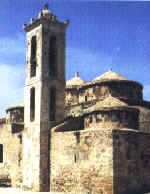
Agia Paraskevi Church
Out of City, Area 1:
Geroskipou Folk Art Museum
Geroskipou village, 3 km East of Pafos, Tel: (06) 24 02 16
Name of the village comes from Greek phrase 'Ieros Kipos', sacred garden of Aphrodite. A fascinating collection of folk arts and crafts is exhibited in beautiful Chatzismith house.
Agia Paraskevi Church
Geroskipou village, 3 km East of Pafos, Tel: (06) 26 18 59
One of the most interesting Byzantine churches on the island, dating back to 10th century. It is a basilica surmounted by five domes forming a cross and has beautiful mural paintings dating from 8th to 15th centuries.
Sanctuary of Aphrodite
Kouklia village, 14 km East of Pafos, off the Lemesos - Pafos road, Tel: (06) 43 21 80
Palaipafos, Old Pafos, was one of the most celebrated pilgrimage centers of the ancient Greek world and once city-kingdom of Cyprus. Here stood famous Sanctuary of Aphrodite, the most ancient remains of which date back to 12th century BC. Glorious days of sanctuary lasted till 3rd-4th century. Museum, housed in Lusignan Manor, contains many interesting finds from the area, and excavations continue on the site of the sanctuary, city and necropolis.
Petra Toy Romiou-Birthplace of Aphrodite
25 km East of Pafos
According to legend, Aphrodite, goddess of love and beauty, rose from waves in this strikingly beautiful spot. Greek name, Petra tou Romiou 'Rock of Greek' is associated with legendary frontier-guard of Byzantine times Digenis Akritas, who kept marauding Saracens at bay with amazing strength. It is said that he heaved this large rock into the sea destroying enemy's ship.
Panagia Chryseleousa Church
Polemi village
A complex of two churches. The oldest is the Northern one, which is a domed cross-in-square type building, possibly of 12th century. Later in 18th century, a barrel-vaulted church was added to the South. Excellent 16th century icons survive on the iconostasis.
Metochi Monis Kykkou
Polemi village
An interesting group of buildings of traditional architecture, known as "Metochi tou Kykkou", can be found in the Northwestern part of the village. Today it is used as a Cultural Center for local community.
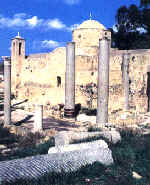
Panagia Chrysorrogiatissa Church and Early Byzantine Basilica
Out of City, Area 2:
Pegeia
Agios Georgios Basilica and fountains of Pegeia
Pegeia village, 19 km Northwest of Pafos
Near a fishing refuge, 4.5 km from the village of Pegeia, are the ruins of two Early Christian basilicas with some very interesting mosaic floors depicting animals. This site must have been an important establishment in Early Christian times. There are also rock-hewn tombs of Roman period above the sea. Pegeia is famous for its fountains in the stone paved village square.
Maa-Palalaiokastro
Coral Bay, 9 km from Pafos
This is an area, which accommodated the first ancient (Mycenaean) Greeks, who immigrated to Cyprus at around 1200 BC, after the fall of Mycenaean Kingdoms in mainland Greece. This is a very important site for Cyprus, because this is where Hellenism on the island originated.
The little museum with its unusual architecture, is of Andrea Bruno's works, Professor of University of Turin and one of Europe's greatest architects. Museum depicts the colonization of Cyprus by Mycenaean Greeks.
Agios Neofytos Monastery
9 km North of Pafos
Founded at the end of 12th century by Cypriot hermit and writer Neofytos. "Egkleistra", an enclosure carved out of the mountain by hermit, contains some of the finest Byzantine frescoes dating from 12th to 15th century. In the monastery church, which contains some of the most beautiful icons of Post-Byzantine period of 16th century, is a very interesting ecclesiastical museum.
Lempa
5 km from Pafos
At Lempa village excavations have brought to light an important settlement of Chalcolithic period. Near the site replicas of two houses from this period have been constructed.
Chrysorrogiatissa Monastery
40 km Northeast of Pafos, turn right before Stroumpi village. Monastery is also reached from Kykkos Monastery via the forest.
Set in beautiful surroundings, monastery, originally founded in 12th century AD, is dedicated to "Our Lady of Golden Pomegranate". Monastery, whose present building dates back to 1770, has a collection of important icons and treasures. An impressive religious ceremony and celebrations are held on 15th August. Old winery of the monastery produces some of the best vintage wine of Cyprus.
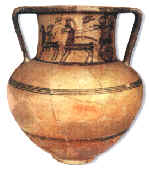
Krater (Jar)
Cypro-Geometric III Period (850-725 BC)
Out of City, Area 3:
Agios Kirykos and Agia Ioulitti Church
Letymvou village
A cross in square domed church that could be dated to 12th century, with many newer additions, especially in 15th century. It has a few surviving wall paintings, dating to 12th century, but most date back to 15th century.
Church Of Panagia Chryseleousa
Empa village, 3 km North of Pafos
This is a combination of two churches. Eastern section was first built in 12th century, possibly on the ruins of an early Christian basilica, as a cruciform church with a dome. Later in 13th century an extension was made to the West with a domed building of the cross-in-square type. It retains valuable wall paintings of 12th, 13th, 15th and 16th centuries.
Panagia Tou Sinti Monastery
Pentalia
An abandoned monastery on the banks of the Xeros River. The central nave of the monastery, dating to 16th century, is in good condition and is considered one of the most important buildings of Venetian period. In 1997 it received Europe Nostra award for the restoration and conservation work carried out on it.
Pano Panagia
On the West of Troodos 1.5 km from Chrysorrogiatissa Monastery
Birthplace of Archbishop Makarios III, first President of Cyprus. The house, where he was born, has been converted into a museum.
Laona Region
Near the town of Poli Chrysochous and Akamas area at about 600 m above sea level, lie the villages of Laona, e.g. Ineia, Drouseia, Kathikas, with a panoramic view across the area. In Ineia you could visit Museum of Basket-weaving (Tel: (06) 33 25 62). Laona/Akamas Information Center could be found in a renovated school in the center of Kathikas. A Museum of Weaving operates in Drouseia.
Polis Chrysochous
37 km North of Pafos
Polis tis Chrysochous lies where there once stood the ancient city-kingdom of Marion, an important commercial center in Classical and Hellenistic times. New local Museum of Polis, Marion/Arsinoe, (Tel: (06) 32 29 55) and houses an interesting collection of antiquities found in the region. Of interest in the center of the town is barrel-vaulted church of Agios Andronikos, which dates back to 16th century.
turned into a mosque during Turkish period, when the Northern part was added to it and wall paintings were covered by asbestos wash. Recently all the wall paintings, dating back to 16th century, have been uncovered. Next to this church lies 18th century church of Agia Kyriaki.
Beautiful beaches could be found in the surrounding region, picturesque villages as well as interesting churches, such as churches of Agia Aikaterini (16th century) and Panagia Chorteni (15th century). The area has become an attractive popular resort.
Baths Of Aphrodite
Akamas Peninsula, near Polis, 48 km North of Pafos
According to legend, goddess Aphrodite used to take her beauty baths in a pool of a natural grotto, shaded by a fig tree, which can still be visited. Nature trails set off from Akamas to lead nature lovers to incomparable views of un-spoilt land.
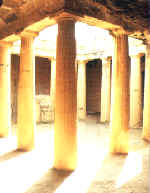
Tombs of Kings
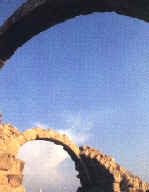
Saranta Kolones
|
|






